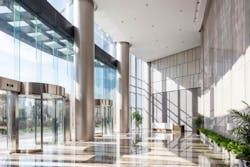5 Important Tasks for Reopening Buildings During COVID-19
Buildings that closed during the COVID-19 pandemic are now facing a long to-do list.
Shuttering facilities for weeks creates all sorts of consequences—some predictable, like the need to screen visitors for COVID-19 symptoms, and some you may not have anticipated, like potential issues with your water.
Make sure these five things are in order before employees, tenants and guests start occupying your building again.
1. Is your piping safe?
If your building has sat empty or been underused for the last couple of months, your pipes might present several hazards.
If you haven’t been flushing water through the pipes, the chlorine your city uses to clean the water may have dissipated, so it’s no longer offering you the protection it used to.
That means people who use your toilets, faucets, fountains and showers are at risk for Legionella and other bacteria, according to Patrick Boyle, director of corporate sustainability for Sloan.
“Water sitting in the building is stagnant, so you need to refresh the water in the plumbing system,” Boyle explains. “The best thing to do is to purge the building’s entire water system to ensure there’s fresh water now present and the chlorine levels are at a safe level.”
Part of reopening buildings means flushing water through every single water fixture in your building, from restroom fixtures to the eyewash station.
Sloan recommends that you:
- Start the water-purging process with the toilets and urinals furthest from the branch lines.
- Flush the first toilet and/or urinal at least three times. Pressure-assisted and tank toilets should all be flushed at least three times; other types can be flushed twice.
- Ultra-low-flow urinals (below 0.25 gallons per flush) should be flushed five to six times.
- Replace cartridges for water-free or hybrid urinals.
- Remove faucet aerators and sprayheads, then allow faucets to run for at least 90 seconds. Clean the aerators and sprayheads before reattaching.
- Run showers at full opening (using both hot and cold) for at least three minutes.
- Inspect and flush all other water-using appliances, including ice machines, dishwashers, water fountains and emergency eyewash stations.
If you don’t already have one, create a water management plan to reduce the potential for water-borne pathogens to grow.
ASHRAE 188 spells out the requirements, and the CDC also provides a toolkit for facilities teams to keep water safe.
Water management plans are customized to each facility, so you can be sure you’re covering all of your building’s bases.
[Related: Legionnaires’ Outbreak: What It Is and How to Prevent It]
2. Have you kept up with pest control?
Rising temperatures encourage pest movement, and the lack of foot traffic in normally busy facilities is likely encouraging pests to move around more than they typically would, explains Dr. Brittany Campbell, staff entomologist and research scientist for the National Pest Management Association (NPMA).
This is especially true if you didn’t continue your regular pest control services while your building was unoccupied or under-occupied. Before you start reopening buildings, it’s crucial to do a pest inspection.
“Even if your building isn’t ready to open up yet, this is a great time to start looking for the signs of pest activity,” says Campbell. “Have someone walk around the exterior of the building. Look for trees, bushes or any type of landscaping touching the building and cut that back. Check for burrows around the building and look for droppings. Try to fill up any openings with an appropriate sealant to keep pests from the outside from actually getting in.”
White Paper Download: Extending the Reach of PoE Powered Devices
This paper discusses increased challenges with an expanded network, gives a brief overview of power over Ethernet, and introduces an innovative solution from Berk-Tek to help you take PoE and PoE+ to new distances.
Depending on the most common pests in your area, you might also spot egg cases from cockroaches and gnaw marks or damaged packaging from rodents.
Be sure to call in your pest control provider as soon as you can to re-establish your regular pest control program and get on top of any signs of pests you spotted during your inspection.
3. Is your fire safety plan impacted by new layouts?
To prepare for reopening facilities, your facilities team might have moved seating for employees and otherwise rearranged furniture to make sure people can maintain a safe distance from each other.
These changes might have created a fire safety violation, says April Musser, fire protection engineer with Telgian Engineering and Consulting.
“In facilities where they’re rearranging furniture or changing the floor plan to maximize social distancing, it can potentially narrow aisleways below the required dimensions, create longer paths of travel or create dead ends that exceed what’s allowed by code,” she explains. “You really should have a life safety consultant look at the new floor plans and make sure you haven’t created any issues that could potentially impact egress.”
Make sure you haven’t blocked any exit doors while you’re rearranging furniture, Musser advises.
If you’ve instituted any other changes to how people move throughout the building—for example, encouraging people to use stairwells instead of elevators to maintain social distancing—you also need to ensure that you’re doing so in a way that doesn’t violate fire safety requirements.
In the stairwell example, that would mean not allowing people to prop open the fire doors protecting the stairwell.
“We can’t let our fear of this virus create a fire protection and life safety risk that could potentially harm people,” Musser says. “We need to balance that need for creating social distance and protecting people with these fire protection and life safety requirements.”
You also may have missed important inspections while the building was closed, Musser says.
Catch up on your monthly fire extinguisher inspections, sign fire tags and confirm that you didn’t miss any equipment dates.
Test your emergency lighting if you missed your regular monthly test and update your maintenance paperwork.
Also, check to make sure your annual maintenance and inspection window for fire pumps, sprinklers and alarms didn’t fall during the closure period; if you did miss the window, get that done right away to make sure there are no issues with how the system operates during a fire.
“When in doubt, fire protection consultants and professionals are there for you,” Musser adds. “If you have a legitimate fire protection concern in your facility, just pick up the phone and call.”
4. Is your access control system controlling the flow of people?
Your access control system should still be functioning as it always has, keeping track of who goes in and out of your space.
In the age of COVID-19, your access control system can do more for you.
Visitor management systems like Proxyclick can be used to enable touchless check-in and access (thus reducing the number of surfaces people touch).
They can even be configured to ask people about potential COVID-19 symptoms, explains Proxyclick CEO Gregory Blondeau.
For example, you might have your visitor management software ask people whether they’ve been in contact with anyone who has tested positive for COVID-19 and whether they have any of a list of symptoms associated with the virus.
Negative answers to both yield credentials (in Proxyclick’s case, a QR code) that opens your turnstile or otherwise permits the visitor to enter your space.
“You need to be able to communicate with your visitors and ask them questions like this to define who’s authorized to come in and who’s not,” Blondeau says. “A level of dynamic intelligence that’s changing every day isn’t automated into access control systems, but with COVID that could change every day depending on the answers to those questions.”
5. Are people observing social distancing the way you intended?
Where do people congregate in your facility?
Many organizations are reconfiguring furniture layouts to help people avoid person-to-person contact and slow the spread of the virus, but without data on where people are, you can’t be sure that your reconfiguration is working.
IoT sensors throughout your facility let you see which areas are most densely populated and the paths people typically take through your space.
“When people are coming in, facilities managers need to look at what areas of the workplace are typically the most densely populated. Where am I likely to have problems?” says Mark Milligan, senior vice president of marketing for technology company Enlighted, an IoT solutions company that captures this kind of data. “Look at the ways people come into the building. What are their paths through the office? Where do people typically congregate? Can I make some changes to increase social distancing and make employees safer?”
Review the data throughout the reopening process and use the insights you gather to update your layout as needed.
You may discover that people are congregating or moving through the space in new ways you didn’t predict, requiring further changes.
You can also use it to verify that the cleaning staff is indeed going everywhere they need to go, Milligan adds.
Additional real-time capabilities can alert you when an area exceeds your occupancy limits and provide contact tracing if someone tests positive for COVID-19 after having been in the workplace.
“Take it slow and be safe,” Milligan advises. “We all want to get business back to as normal as possible, but protecting employees has to be the most important thing. Take it a step at a time.”
Reopening Resources
IFMA’s Coronavirus Preparedness Resource Center hosts a spectrum of resources for FMs, including a free pandemic manual from the IFMA Foundation that includes checklists, measures for pandemic control and mitigation and more.
BOMA International’s Coronavirus Resource Center features valuable guidance for property professionals, including a lengthy guidance document focused on reopening buildings safely.
The Institute for Real Estate Management (IREM)’s resources for the industry include podcasts, on-demand courses and a pandemic guide for reopening facilities.
The 20-part accreditation process covers:
- Standard operating procedures
- Tools, equipment and chemicals
- Personal protective equipment (PPE)
- Waste management
- Training
- Emergency response planning
- Worker health
- Sourcing
Facilities that have committed to earning the accreditation include the Orange County Convention Center in Orlando, FL, the Staples Center in Los Angeles and Lincoln Financial Field in Philadelphia.
Learn more and apply for accreditation at gbac.org.
Read next: COVID-19: Complete List of Coverage
About the Author
Janelle Penny
Editor-in-Chief at BUILDINGS
Janelle Penny has been with BUILDINGS since 2010. She is a two-time FOLIO: Eddie award winner who aims to deliver practical, actionable content for building owners and facilities professionals.

